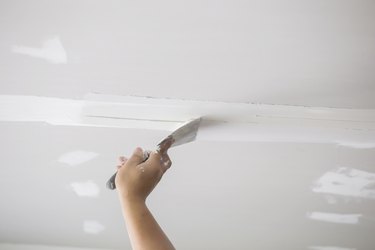
No drywall installation is complete until you've taped the seams and applied two or three finish coats of joint compound, and this is arguably the most important part of the job. A good tape-and-finish job can make defects like uneven seams and gouges disappear completely. You need two different kinds of joint compound (mud) to do a bang-up job. All-purpose mud, or taping mud, is best for embedding the tape and filling nail and screw holes, but pros generally switch to topping compound for the top coats. Topping compound is lighter, easier to apply and sand, and shrinks less than all-purpose mud.
The Difference Vinyl Makes
Video of the Day
Both all-purpose joint compound and topping compound are drying compounds, which means they harden when all the water they contain evaporates. The ingredients in all-purpose mud include limestone, gypsum, mica, talc (for lubrication) and clay (for adhesion). Topping compound contains many of the same ingredients, but instead of clay, it has a small amount of vinyl acetate. The omission of clay makes topping compound unsuitable for taping joints, but the addition of vinyl makes it easier to spread, level and sand. Add the fact that topping compound can weigh up to 35 percent less than all-purpose joint compound, and it's easy to see why pros prefer it for finishing.
Video of the Day
Dry or Premixed
Both all-purpose mud and topping compound come in premixed and powdered forms. When you use them properly, both types give the same final results. Although premixed mud is easier to use for novices, pros prefer powders because they can be safely stored. When you store premixed products, they tend to harden in the container after a month or two, and bits of hardened material create headaches when taping and finishing. Pros also like to mix their own mud to get just the right consistency. You can add water to a premixed compound to thin it, but the process is easier and more accurate when you start with a powder. These considerations aren't necessarily important for DIYers working on small projects, most of whom probably prefer the ease of use of premixed products.
It's always a good idea to keep a small amount of all-purpose and topping joint compound in your paint closet for small repairs. If you do this, they should both be the powdered variety. Be sure to keep the bags closed to keep moisture out.
Taping and Finishing Basics
Drywall finishing can take three to four days because, depending on humidity and temperature, it can take each coat of mud from 12 to 24 hours to dry. The first step in this multistep process is to apply a coat of all-purpose compound to the seams, lay drywall tape on top and scrape the tape flat, removing excess mud in the process. Once the mud dries, apply two or three more coats of mud, scraping each flat with a progressively wider drywall knife and letting it dry before applying the next coat. It's best to use all-purpose compound for the first of these finish coats because it has good durability and adhesion. Use topping compound for the final two coats. Sand the final coat lightly when it dries and the drywall is ready for priming and painting.
When to Use Hot Mud
Setting-type joint compound is an alternative to all-purpose mud for taping. This type of joint compound hardens chemically, and because it sets quickly, it reduces the overall time needed for finishing. It also resists cracking better than drying compounds, but it does have disadvantages. It's more difficult to sand, and you have to use it during its "open" time, which can be a matter of five minutes to an hour, depending on which type you use. Once it starts to harden, it becomes unusable, and you can't soften it by adding water.
Pros like to use hot mud for taping and the first finish coat because it can turn a four-day job into a three-day one, and it's the product you should use with fiberglass tape. Because it's more finicky than simple drying mud, however, it takes skill to use it. If you work with drywall only occasionally, it's probably best to stick with conventional mud.